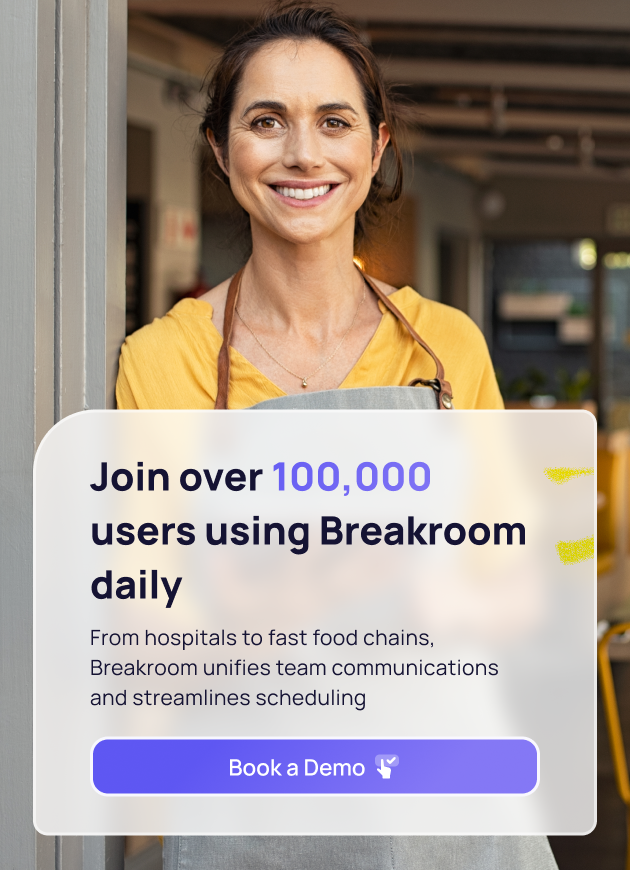You're managing a shift at your third location when someone calls out sick. You need coverage in the next two hours. So you do what most managers do: you start texting.
You text Maria. No response. You text Jordan. They're already working at another location. You text five more people. Your personal phone is now a chaotic thread of work conversations mixed with family photos and doctor's appointment reminders.
This is how most multi-location businesses communicate. And it's a mess.
Should I text my staff?
The short answer: not from your personal phone.
Informal communication is foundational to every business; it’s the glue that keeps teams running. Texting staff has become the default channel because it's fast and everyone already uses it. But personal texting for informal communication creates more problems than it solves.
When you text staff from your personal number, you're giving out information you can't take back. Employees keep your number after they leave. You can't track who saw important messages. Conversations get buried under personal texts. Group chats become unmanageable when someone quits, and you have to recreate everything from scratch. A text from an unknown number comes through that says “hey it’s Jordan” and you don’t know if it’s “employee Jordan” or “guy-who-asked-for-your-number-Saturday Jordan”. Yikes!
101 Express, a Bay Area automotive business with five locations, dealt with exactly this. Owners, managers, and employees texted each other separately. Information got siloed. Managers spent hours communicating the same update to different people. Employees didn't report issues because reaching the right person meant scrolling through dozens of texts.
After switching to a dedicated work communication platform, they cut employee churn by 43% (https://www.breakroomapp.com/customer-stories/101-express).
Why personal texting fails at work
Personal texting wasn't built for business operations. Here's what breaks:
You lose control. You can't remove someone from a text thread. You can't delete inappropriate messages. You can't track whether critical information was actually read.
You make mistakes. A text meant for your partner or regional manager gets sent to the affected staff member, and now you’re doing crisis management to clean up a big mess.
Privacy disappears. Your personal number is now company property. Staff can reach you anytime, anywhere. There's no boundary between work and home.
Nothing scales. What works for five employees stops working at fifteen. Group texts become unreadable. You can't separate conversations by location or department. Finding that schedule from two weeks ago means scrolling forever.
Compliance gets messy. When Wendy's needed to prove they posted schedules 14 days in advance to comply with Oregon's predictive scheduling law, text messages wouldn't cut it. They needed a system that tracked exactly when managers shared schedules across all 500+ team members.
What works instead
The businesses that get team communication right use tools built for the job. Not enterprise software that requires IT support. Just straightforward platforms that do a few things well.
Coastal Calibration reduced staff meetings by 40% after moving from scattered texts and emails to organized channels (https://www.breakroomapp.com/customer-stories/coastal-calibration). Operations, sales, and finance each got their own space. Customer payments got communicated to finance immediately instead of through phone tag. When someone left, removing them was simple and message history stayed intact.
Here are the features that actually matter:
Separate work from personal. Your team downloads an app. Messages go there, not to personal phones. You keep your number private. Employees can turn off work notifications after their shift without missing personal texts.
Announcements that land. Instead of texting the same update to twelve people individually, you post once. Read receipts show you who saw it. You can follow up with the three people who didn't.
Real scheduling tools. Build a schedule from your phone in minutes. Copy last week's schedule if it worked. Team members get notified automatically when you publish or change shifts. Everyone can check their schedule anytime without texting you to ask.
Channels that make sense. Create separate conversations for different topics. One for shift coverage. One for maintenance issues. One for manager-only discussions. Information stays organized instead of buried in a massive group text.
The difference this makes
Taco Bell rolled out Breakroom to 30,000+ team members across 1,000+ locations (https://www.breakroomapp.com/customer-stories/taco-bell). Average onboarding time: two days. Weekly usage: 90%.
Argos, a pet boarding business, tried Google Hangouts, email, texts, phone calls, and even handwritten sticky notes before finding something that worked. When they needed to broadcast urgent updates about aggressive pet behavior or medication requirements, text threads couldn't handle it. With the right platform, everyone got notified immediately and managers could see who read the message (https://www.breakroomapp.com/customer-stories/argos-pets).
The operations director said it best: "The one thing that's been the bane of my existence as leadership is how do I communicate effectively with everybody?"
That's the real question. Not whether you should text staff, but whether your communication setup actually works for your business.
Making the switch
Moving off personal texts feels like a big change. It isn't.
You invite your team using phone numbers. Takes a few minutes. They download an app. Most teams are fully onboarded in under a week. Nobody needs training on how to send a message or check a schedule.
The businesses in food service, healthcare, caregiving, retail, and logistics that made the switch report the same pattern: fewer missed messages, less time spent on scheduling, better transparency across locations, and lower employee churn.
Because when your team knows what's happening and can actually reach you when they need to, fewer things break.
Text staff if you want. Just use the right tool for the job.








